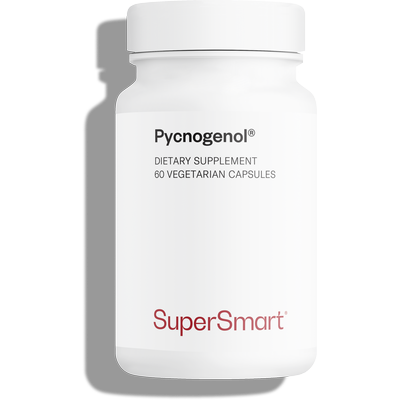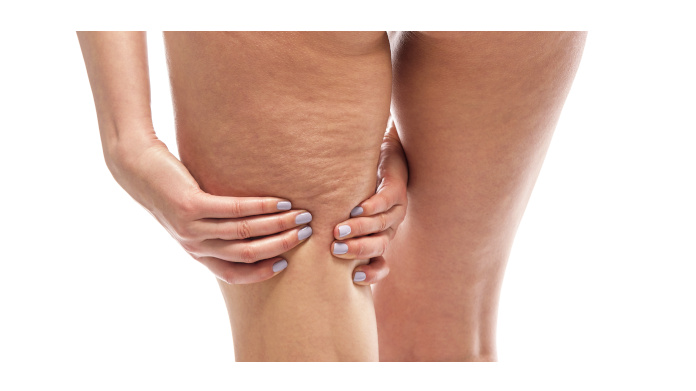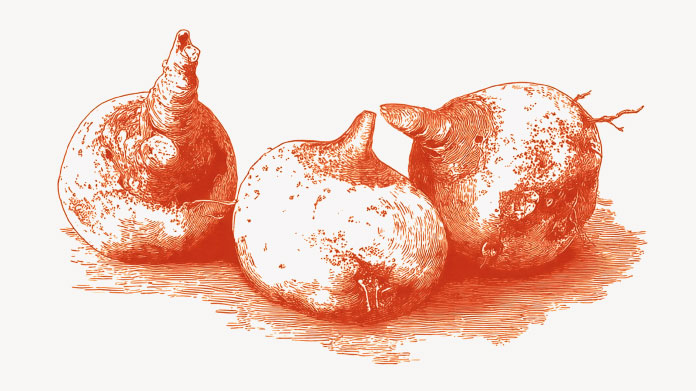
What is cellulite and how does it form?
Definition and appearance of cellulite
Cellulite refers to an accumulation of fat under the skin which, by pushing against the surrounding tissue, gives it the typical bumpy appearance of dimples.
These are also the origin of its common nickname of ‘orange peel skin’.
It mainly affects women, particularly around the thighs, buttocks and hips – the so-called ‘saddlebags’.
It can also be found on the stomach or arms, particularly in overweight people.
However, its development is not directly linked to the weight of the person concerned.
Whether you're slim or plump, cellulite can affect anyone. In fact, it is estimated that more than 80% of adult women suffer from it (1).
Causes of cellulite
Biologically, cellulite is the result of a complex set of mechanisms:
- an increase in the size of adipocytes (fat cells), even in people who are not overweight;
- local or more general water retention;
- local tissue inflammation;
- dysfunction of blood and lymphatic microcirculation;
- fibrosis of connective tissue (a change in its constitution causing it to lose its properties).
These mechanisms are influenced by various factors:
- hormonal variations (which can affect fat storage or water retention);
- genetics (generally hereditary);
- diet (too rich in fats, refined sugars, salt, etc.);
- level of physical activity (which contributes to weight regulation and tissue drainage);
- stress (which influences hormone production in particular).
Because of its impact on self-image, cellulite is the subject of research targeting the action of certain substances on microcirculation and inflammation.
Study suggests beneficial action of pine extract on cellulite
A clinical study published in May 2025 suggests that a patented extract of maritime pine bark called Pycnogenol® may help reduce certain visible signs of cellulite (2).
The research, conducted on 60 women aged 25–45 with moderate cellulite, evaluated the effects of daily Pycnogenol® supplementation for 60 days.
The results show a significant improvement in various aspects of cellulite, with:
- an improvement in the clinical cellulite score of 12.2% (after 2 months) and 13.6% (after 3 months) in the test group, compared with an insignificant improvement in the placebo group;
- a significant reduction in thigh circumference, of 2.07 cm on average, after 3 months in the test group, compared with only 0.9 cm in the placebo group;
- a 32% reduction in skin roughness after 3 months in the test group, compared with just 6% in the placebo group;
- a significant increase in skin smoothness over time in the test group compared to the placebo group.
It should be remembered, however, that these results, while encouraging, still need to be confirmed by further, larger-scale studies.
Focus on Pycnogenol®, a patented active ingredient from maritime pine
An action on blood circulation
Pycnogenol® is a patented extract of maritime pine (Pinus pinaster) bark grown in south-west France.
This natural extract has been studied and is recognised for its properties in vascular health. In fact, it helps to support microcirculation by reducing excessive permeability, which limits micro-leaks (3).
It also contributes to good general blood circulation by protecting blood vessel walls against the effects of oxidative stress.
These properties, due to its high content of OPCs, a group of valuable flavonoids, could explain some of the potential effects observed in cellulite management (4).
Improved blood circulation leads to better tissue drainage, which could be responsible for the reduction in thigh circumference.
Anti-oxidant properties
More generally, maritime pine bark also helps to protect all cells and tissues against oxidative stress, which is responsible for premature cell ageing.
Its antioxidant properties could therefore explain the improvement in skin smoothness, with better-protected cells less prone to ageing.
Free radicals, responsible for the oxidative stress that causes cell damage, also trigger inflammatory reactions.
Acting like an anti-free radical 'shield', Pycnogenol® could reduce this tissue inflammation observed in cases of cellulite.
When the tissues under the skin are less inflamed, they become less swollen and less sensitive. This can also help to smooth the skin's surface and reduce the 'orange peel' appearance.
Pycnogenol® and natural collagen
A number of scientific studies also suggest that Pycnogenol® may play a supporting role in the production of collagen, a protein essential for skin firmness and elasticity (5).
In particular, it inhibits the excessive activity of several enzymes involved in the deterioration of collagen and skin tissue in general.
What's more, its antioxidant properties can indirectly protect collagen from damage caused by free radicals.
Oxidative stress has the harmful effect of destroying the collagen fibres present in tissues.
The actions of Pycnogenol® could help maintain the structure and tone of connective tissue, which is often impaired in cases of cellulite.
![]() Discover the Pycnogenol® food supplement made from Landes pine and standardised in oligo-proanthocyanidins (OPC).
Discover the Pycnogenol® food supplement made from Landes pine and standardised in oligo-proanthocyanidins (OPC).
SUPERSMART ADVICE
References
- Bass LS, Kaminer MS. Insights Into the Pathophysiology of Cellulite: A Review. Dermatol Surg. 2020 Oct;46 Suppl 1(1):S77-S85. doi: 10.1097/DSS.0000000000002388. PMID: 32976174; PMCID: PMC7515470.
- Liu, Q.; Wu, J.; Wang, N.; Burki, C.; Grether-Beck, S.; Krutmann, J. Un extrait d'écorce de pin maritime français soulage la cellulite : une étude clinique en double aveugle, randomisée et contrôlée par placebo, Phytomedicine Plus , 2025. 5
- Weichmann F, Rohdewald P. Pycnogenol®French maritime pine bark extract in randomized, double-blind, placebo-controlled human clinical studies. Front Nutr. 2024 May 2;11:1389374. doi: 10.3389/fnut.2024.1389374. PMID: 38757130; PMCID: PMC11096518.
- D'Andrea G. Pycnogenol: a blend of procyanidins with multifaceted therapeutic applications? 2010 Oct;81(7):724-36. doi: 10.1016/j.fitote.2010.06.011. Epub 2010 Jun 20. PMID: 20598812.
- Marini A, Grether-Beck S, Jaenicke T, Weber M, Burki C, Formann P, Brenden H, Schönlau F, Krutmann J. Pycnogenol® effects on skin elasticity and hydration coincide with increased gene expressions of collagen type I and hyaluronic acid synthase in women. Skin Pharmacol Physiol. 2012;25(2):86-92. doi: 10.1159/000335261. Epub 2012 Jan 21. PMID: 22270036.
2 Days
Excellent quality products with…
Excellent quality products with innovative formulas, as someone who has been suffering with acid reflux, these supplements have been lifesavers.
Oriana Moniz
2 Days
high quality supplement!
high quality supplement!
GALANT
3 Days
Good service prompt delivery
Good service prompt delivery
Mrs Marcella Reeves
8 Days
I like your clear explanation
I like your clear explanation. And how to make a choice of products for a specific health problem
Ingrid
14 Days
Great product and it arrives quickly.
Great product and it arrives quickly.
SOMMARIVA Gianni
15 Days
Excellent products and fast service.
Excellent products and fast service. What do we need more?
Margarida
19 Days
The variety of products is amazing
The variety of products is amazing, the offers are good and the sending is very fast. I just miss having a bit more of guidance about combinations, possible interactions, etc.
Maria Angeles Verdu
21 Days
It was quick
It was quick.
Timo Antero
23 Days
Who is a good boy? You, you are! Yes, yes
:) :(:) :(:) :(:) :(
JORGE Catalan Gasco
26 Days
Excellent online site
Excellent online site, efficient and quick delivery. A great experience.
Chris
29 Days
I’m really happy with your products, but…
I’m really happy with your products. Indeed, I’ve been a customer of SuperSmart for a long time. However, I believe that lately you’ve made a significant mistake in choosing Poste Italiane for your deliveries. Poste Italiane is now over loaded and assigns the deliveries to small local companies that have grown like mushrooms because of this business. However, the service they provide is very poor. They let you know about the delivery date just the evening before, with no time to organize yourself, many times you receive a message saying that they tried to deliver but you were not home and in reality they haven’t come at all and, when they do come, you open the door of the building ( I live on the 3rd floor) and when you get downstairs they have already left, leaving the pack inside but right behind the glass door instead of at least putting it on top or under the letterbox. This is not just a one time event but it’s their way of proceeding. It would be worth hiring a professional currier. Thanks
Olga Gladys Del Signore
29 Days
Good products
Good products, fast service
Mrs I Heinrich
35 Days
Quality products and fast shipping.
Quality products and fast shipping.
JF
37 Days
Everything is great. Keep up
Your product and service is great that's why i ordered again.
KOSMATOS Stamatios
41 Days
everything as expected
the products work and the processes to support them also
Ruggero Benedetto




